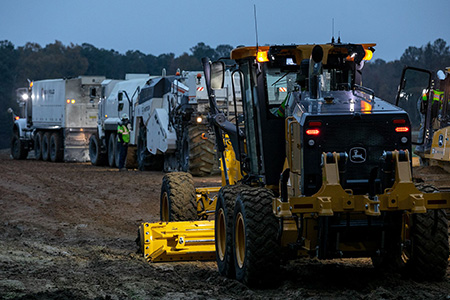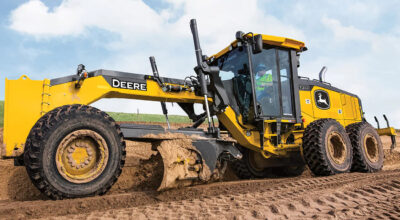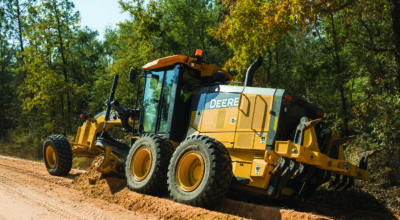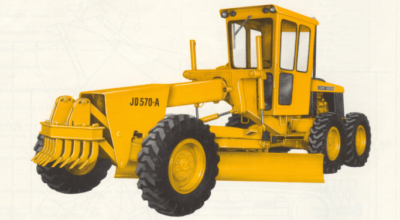The right John Deere motor graders can make the difference between a smooth, precise road or highway surface and uneven, unreliable terrain. Your choice of grader also influences the ease and speed of the task. John Deere G-Series Graders stand out for their balance, reliability, and power. In this blog post, we’ll compare the features, specifications, and performance of two heavy-duty models — the 772G and the 872G — to help you understand which grader is right for you.

What is a John Deere 772G Motor Grader?
The 772G is one of the largest models in the John Deere G-Series Grader lineup, providing power, precision, and durability. This motor grader is a common construction equipment that is used in civil engineering projects, such as leveling and smoothing the surface of roads and highways. It has a John Deere PowerTech™ PSS 9.0L engine compliant with EPA Final Tier 4/EU Stage V emission standards. It features a 6-wheel drive system, automatic dual-path hydrostatic drive, and a powerful transmission.
What is a John Deere 872G Motor Grader?
Like the 772G, the John Deere 872G motor grader is designed for commercial grading tasks. It’s the largest, heaviest, and most powerful G-Series Grader, capable of handling the toughest terrains. Similar to the 772G, the 872G features a PSS 9.0L engine, a 6-wheel drive system, and automatic dual-path hydrostatic drive. A key difference between the 772G and 872G is the 872G provides a higher engine output and greater net peak torque.
John Deere 772G vs. John Deere 872G: Key Features
The 772G and 872G motor graders share several similarities, including:
Exceptional and Improved Performance
Both the 772G and 872G are formidable workhorses, capable of tackling tough spots and steep hills effortlessly. Operators can seamlessly regulate speed using a dial switch instead of the traditional inching pedal. Boasting robust engines, high torque, and excellent blade pull capabilities, both models are capable of handling significant loads.
Outstanding Technology and Automation
Both the 772 and 872 are available as Grade Pro (GP) models. GP models, like the intuitive Automation Suite, come with advanced technological capabilities to reduce the manual burden on operators. The Automation Suite includes features like Auto-Gain for Cross Slope, which adjusts gain settings based on ground speed to maximize performance and boost efficiency.
Seat-Integrated Control Options
The G-Series Graders offer flexibility in how work gets done. Operators can choose between comfortable dual-joystick controls, state-of-the-art electrohydraulic fingertip armrest controls, or traditional motor grader controls on the front of the steering column.
Simple and Easy Maintenance
Ensuring uptime is a top priority for the 772G and 872G models, which are designed with easy maintenance in mind. Service points for fuel and diesel exhaust fluid, engine oil, and hydraulic filters are within easy reach. Additionally, the GP models come equipped with Machine Damage Avoidance, an advanced automation feature that prevents the blade from damaging the machine’s tires or saddle.
Customer-Focused Designs
The design of the John Deere 772G and 872G motor graders reflects John Deere’s commitment to customer satisfaction and safety. These models provide operators with a virtually unobstructed view, ensuring clear sightlines to the heel, toe, and behind the moldboard. They offer high-resolution rearview cameras with dedicated in-cab monitors to further support visibility. Moreover, an LCD hi-vis monitor offers intuitive access to essential machine data.
John Deere 772G vs. John Deere 872G: Key Specs
Taking a closer look at the specifications of the 772G vs. 872G can help you determine which model is best suited for your needs:
Driveline
- Engine Output: The 772G delivers a net power of 205 kW (275 hp). The 872G boasts a higher net power of 224 kW (300 hp).
- Peak Engine Torque: The peak engine torque on the 772G is 1,379 Nm (1,029 lb/ft), compared to 1472 Nm (1,086 lb/ft) of the 872G.
- Torque Rise: The torque rise on the 772G is 50%, whereas the 872G is 46%.
Dimensions
- Overall Length: Both the 772G and 872G measure 8,890 mm (29 ft 2 in) in length.
- Transport Width: The transport width for the 772G is 2490 mm (98 inches), and for the 872G, it’s 2640 mm (104 inches).
- Right/Left Shoulder Reach: The 772G reaches 2,083 (6 ft 10 in) on each side, while the 872G is longer, reaching 2,329 (7 ft 7 in).
Weights
- Operating Weight: The operating weight for the 772G is 17,530 kg (38,648 lb.), compared to the 872G at 18,012 kg (39,710 lb.)
- Maximum Operating Weight: Both the 772G and 872G can handle a 24,948 kg (55,000 lb.) maximum operating weight.
- Typical Weight With Push Block & Ripper: When equipped with a front push block, rear rippers/scarifier, and other equipment, the typical weight of the 772G is 20,500 kg (45,195 lb.), while the 872G is 21,600 kg (47,620 lb.).
Choose the Perfect John Deere Motor Grader for Construction Needs
Choosing between the John Deere 772G and John Deere 872G motor graders ultimately involves understanding your specific construction needs. Evaluate the demands of your projects, considering factors such as terrain conditions and load weights. Whichever model you go with, rest assured that both are supported by a legacy of reliability, innovation, and quality synonymous with the John Deere brand. Contact your local John Deere dealer near you now!

If you enjoyed this post or want to read others, feel free to connect with us on Facebook, Pinterest, Twitter, or Instagram!


